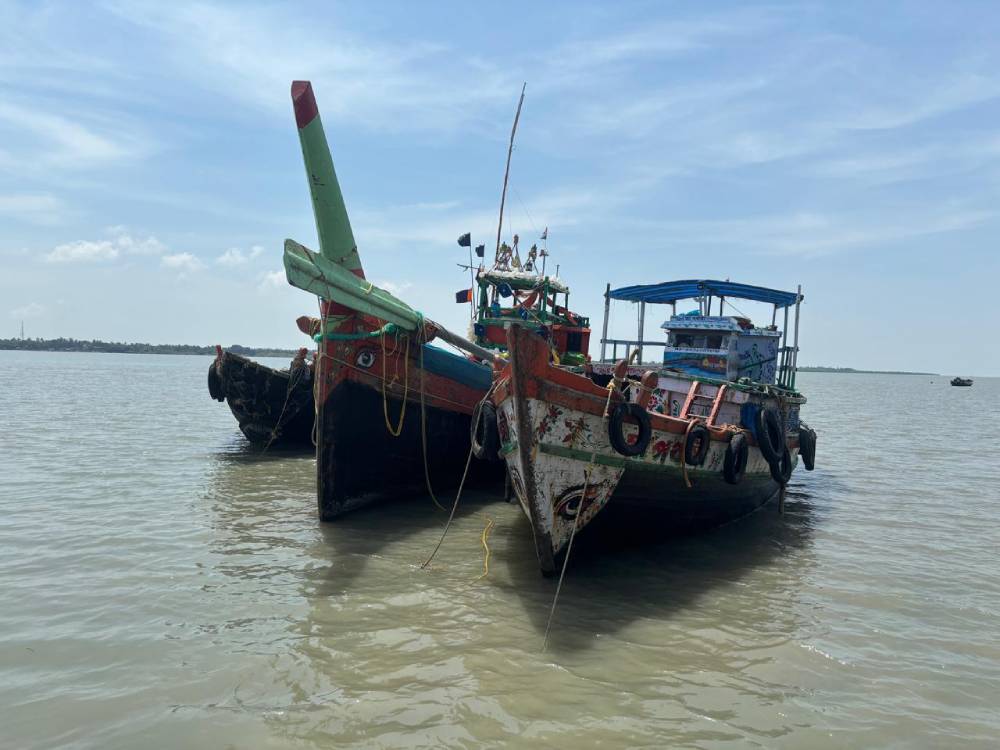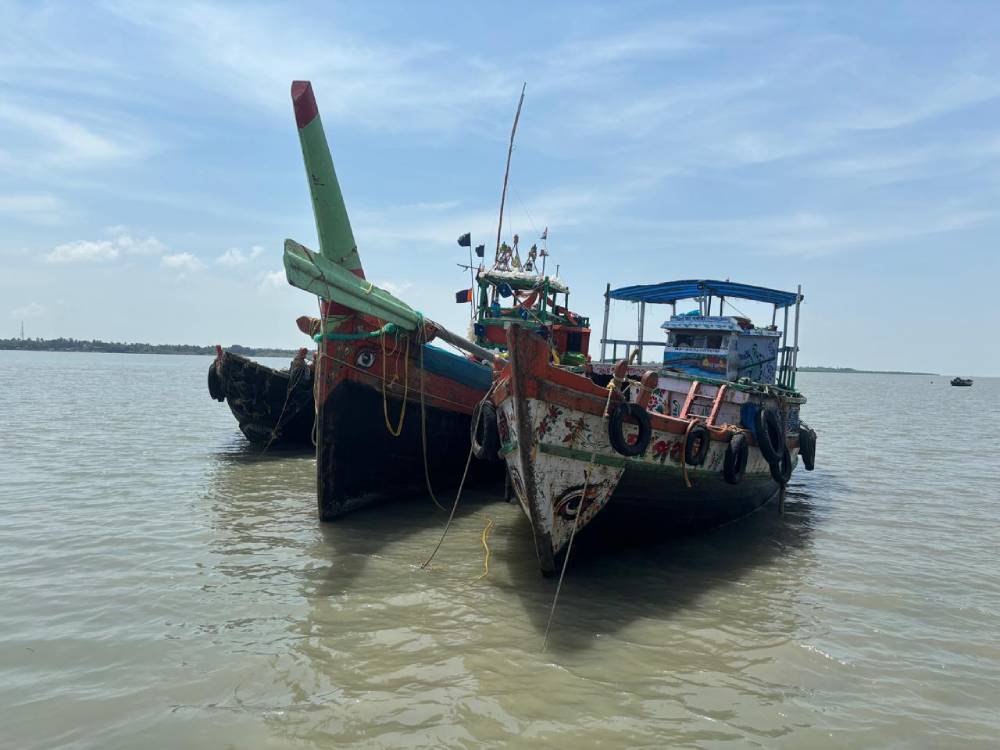
As the salinity level of the freshwater creeks are rising across the Sundarbans’, how is it affecting the fishing communities?
Mrityunjay Bhuinya of Gosaba island in the Indian state of West Bengal usually steps into his diesel-powered wooden boat as the first rays of dawn skim across the Matla River. He remembers when the creeks were alive with freshwater fish- catfish(locally known as singi, magur, tyangra), pabda, khoyra among others. A morning’s catch fed his family and left some to sell in the small market at Rangabelia, in the same island. Now, the river tastes salty. His nets come up mostly empty.
The water comes with a taste in the mouth, he said, and the nets come up with fewer fish. He points to the mud beyond his yard where the embankment used to hold firm and says the river took that land in one night after a big tide last year. The tide he refers is locally known as kotal, or the tidal surge after every ‘purnima’ and ‘amabashya’ or full moon or new moon period.
“In Gosaba, Basanti, Patharpratima, the water was sweet so we used to drink from wells, irrigate our paddy, and catch fish nearby,” he said, scanning the horizon. “Now the water tastes salt. The fish are farther. The income is gone.”
The embankments along Gosaba, built decades ago, creak and leak under the rising tides. Children play near them, unaware that the land they run on is gradually being lost to erosion and saline intrusion. Mrityunjay’s son, Bapi, helps him cast nets, but the boy’s future as a fisherman feels uncertain.
In Mousuni island, 30 kilometers downstream, 45-year-old Abdul Rehman generally fishes using his small boat in the Muriganga river. “I used to spend half a day in the creek and bring home enough for my family and the market,” he said. “Now I row for hours, past the mangroves, into deep waters. Sometimes the net comes up empty. I borrow money for fuel, sometimes from neighbors, sometimes from local moneylenders at a high interest rate.”
Salma Khatun from Baliara village in the same island, sells the catch in the local bazaar or market. “Before, we sold catfish and hilsa for a fair price. Now only small prawns and crabs come, and buyers give little. Sometimes I leave the market empty-handed,” she said. Her husband, also a fisherman, spends long hours traveling to distant estuaries.
The 52-year-old lady notes that fish breeds such as tyangra, pabda, and parshe, or khoyra are now rare in their creeks. “The fish are gone from the shallow waters,” she said. “The fishermen has to go further each day, and the diesel costs more than the fish are worth.”
Across the Indian Sundarbans, households report similar trends. As incomes diminish, children are often pulled from school to help on boats or at the markets.
The fishermen describe the seasonal impacts vividly. During the dry season from December to April, river salinity rises to 21–25 ppt or parts per thousand in Matla, Bidyadhari, and Raimangal creeks. Freshwater fish do not breed in these conditions, and even adult stocks shrink.
According to well established global norms, fresh water with more than 1 ppt is unsuitable for human consumption.
“During these months, we travel up to 15 kilometers away from the village creeks,” says Mrityunjay. “A full day may bring just enough for one meal. Diesel costs 500–700 rupees a day. If the net comes up empty, the loss is mine to bear.”
In Mousuni, Abdul Rehman recalls a week last March when he spent six days on the estuary. He returned with only a fraction of his usual catch, and his family ate only lentil soup with rice that he had to buy. “This is no life,” he said. “We are working more, earning less, and yet we have no choice.”
During the monsoon, from June to September, cyclones and tidal surges make fishing risky. Boats are damaged, nets torn, and embankments breached. Cyclone Amphan in 2020 flooded low-lying areas of the region, forcing many families to abandon their homes temporarily. After the storm passed, returning to their creeks, fishers found the usual breeding grounds destroyed.
Scientific studies confirm what fishers report. A World Bank survey of 2020 found out that in 17 out of 50 hamlets across Gosaba, Hingalgunj, and Patharpratima show tube wellsalinity exceeding 1 ppt, reaching 4.68 ppt in Karikarpara in Hingalganj. River water in the same regions often reads 21–25 ppt, especially in dry seasons. As a result, low-salinity species like pabda, , tyangra, and kholse are failing to breed.
Researchers mapping the delta say that two policy arenas deserve immediate attention: water governance at the basin scale and local resource management. According to them, freshwater pulse dynamics matter. The Ganges-Brahmaputra-Meghna system’s flow into the coastal plain is mediated by headwater dams, diversions, and siltation. When freshwater reaches the Sundarbans in smaller volumes during the dry season, the tidal push from the Bay of Bengal can drive saline water significantly upstream.
Dr. Anamitra Anurag Danda, the Director of Sundarbans Programme, WWF-India , explains: “Rising salinity is slowly eroding the habitats that these fishers rely on. Their struggle is not just about catching fish, it is about survival.”
Experts such as Dr Danda, who have worked with fishing communities emphasize that the problem is not only ecological but institutional. “Small-scale fishers have little voice in the basin-level politics that regulate water allocation, and they are often excluded from local decision-making about aquaculture and embankment repair”, he said.
Mangrove decline further threatens the fishers’ livelihoods. Satellite studies show ~25% of mangrove trees in the Sundarbans, especially Heritiera fomes, are in poor health due to salt intrusion, reducing nursery grounds for juvenile fish. Also the Sundari tree, the eponymous plant on which the entire region is named after is declining fast due to the increase in salinity level.
Local adaptation strategies range from the pragmatic to the precarious. Some households diversify income by taking wage labor in towns, others convert land to shrimp culture when they can access capital, and still others change gears and travel farther to fish. Shrimp and prawn culture can be lucrative, and in the short term it has been adopted by households looking for higher returns. Yet the spread of aquaculture is itself a driver of localized salinization: ponds require saline conditions to be productive, and maintaining those salinity regimes can make nearby soils and water bodies less suitable for freshwater uses.
“Shrimp culture seems profitable,” says Abdul Rehman, “but we cannot afford the ponds or the chemicals needed. And once a cyclone hits, all is lost as the fish spills into the flood water. So, we return to fishing, even though it is getting harder.”
Women’s work has also increased. Salma Khatun says she now spends hours collecting crabs, which are less lucrative than freshwater fish, just to keep household income steady. Children help both in fishing and marketing, often missing school.
Unsurprisingly, this has led to a spike in school dropout and underage marriage. A study published by the West Bengal Commission for Protection of Child Rights(WBCPCR) in February 2025, states that climate related disruptions have led to 70% decline in regular school attendance and a 27% dropout rate in Gosaba and Patharpratima.
The report states that only in the past decade, 55% of the households in the Sundarbans reported a significant rise in underage marriage.
Dr. Danda emphasizes: “Small-scale fishers in the Sundarbans are on the frontline of climate change. Rising salinity, unpredictable rainfall, and cyclones directly threaten their livelihoods.”
World Bank data show that reductions in daily catch force households into cycles of borrowing and migration. Fishers travel farther, spend more on fuel, and often still return with a loss.
Dr Danda further said: “Households that relied on balanced fishing and paddy cultivation now find both strategies undermined. Many face severe food insecurity, debt, and the risk of migration. Climate change has turned everyday survival into a gamble.”
Speaking about a solution, Dr Danda said, “the solutions must be multi-layered. Grassroots measures such as targeted mangrove restoration and the protection of existing nursery creeks can rebuild local ecological function while providing immediate protection from waves and erosion. Basin-level water management, however, remains essential”.
Researchers highlight the role of mangroves in trapping sediment and in providing nursery habitat; restoring mangrove buffers where possible can slow shoreline retreat and improve habitat quality for fish.Along with that, a coordinated approach that secures seasonal freshwater flows for the delta is crucial, which would shrink the reach of saline intrusion and restore the seasonal dynamics many species rely upon.
Yet such cooperation requires political will across districts and states, and, in some cases, across national boundaries of India and Bangladesh.
“Without aligning upstream and coastal policies, piecemeal local interventions will struggle to keep pace with systemic drivers”, said Dr Danda.
As the sun dips below the horizon, Mrityunjay pulls in his nets. A few small prawns and khoyra fish lie at the bottom. Enough for dinner, maybe a little to sell. His children play nearby, their laughter echoing over the salt‑tinged water.
To help fisherfolks like Mrityunjay, the West Bengal Government launched a scheme called Samudra Sathi in 2024, to provide INR 5000 or GBP 50 for two months per year, to aid registered fishers during the annual fishing ban in the Sundarban National Park region. Mrityunjay however feels that is not enough.
“A single kilogram of rice costs around 50 rupees(GBP 0.5)”, said the fisherman. “You can very well imagine what we will manage with that amount”.
“They tell us to plant mangroves, raise embankments, or switch to shrimp,” he said. “I have tried doing some of that. But I want my children to know how to fish, to earn, and to live a life of dignity here. If the river keeps tasting like salt, none of that will be possible. Our life, our river, our future, they are disappearing together.”
